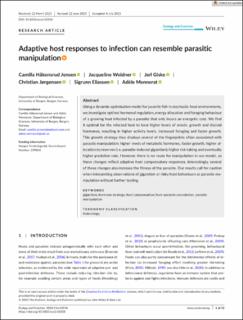| dc.contributor.author | Jensen, Camilla Håkonsrud | |
| dc.contributor.author | Weidner, Jacqueline | |
| dc.contributor.author | Giske, Jarl | |
| dc.contributor.author | Jørgensen, Christian | |
| dc.contributor.author | Eliassen, Sigrunn | |
| dc.contributor.author | Mennerat, Adele | |
| dc.date.accessioned | 2023-08-28T11:00:34Z | |
| dc.date.available | 2023-08-28T11:00:34Z | |
| dc.date.created | 2023-08-15T10:29:31Z | |
| dc.date.issued | 2023 | |
| dc.identifier.issn | 2045-7758 | |
| dc.identifier.uri | https://hdl.handle.net/11250/3085974 | |
| dc.description.abstract | Using a dynamic optimisation model for juvenile fish in stochastic food environments, we investigate optimal hormonal regulation, energy allocation and foraging behaviour of a growing host infected by a parasite that only incurs an energetic cost. We find it optimal for the infected host to have higher levels of orexin, growth and thyroid hormones, resulting in higher activity levels, increased foraging and faster growth. This growth strategy thus displays several of the fingerprints often associated with parasite manipulation: higher levels of metabolic hormones, faster growth, higher allocation to reserves (i.e. parasite-induced gigantism), higher risk-taking and eventually higher predation rate. However, there is no route for manipulation in our model, so these changes reflect adaptive host compensatory responses. Interestingly, several of these changes also increase the fitness of the parasite. Our results call for caution when interpreting observations of gigantism or risky host behaviours as parasite manipulation without further testing. | en_US |
| dc.language.iso | eng | en_US |
| dc.publisher | Wiley | en_US |
| dc.rights | Navngivelse 4.0 Internasjonal | * |
| dc.rights.uri | http://creativecommons.org/licenses/by/4.0/deed.no | * |
| dc.title | Adaptive host responses to infection can resemble parasitic manipulation | en_US |
| dc.type | Journal article | en_US |
| dc.type | Peer reviewed | en_US |
| dc.description.version | publishedVersion | en_US |
| dc.rights.holder | Copyright 2023 The Author(s) | en_US |
| dc.source.articlenumber | e10318 | en_US |
| cristin.ispublished | true | |
| cristin.fulltext | original | |
| cristin.qualitycode | 1 | |
| dc.identifier.doi | 10.1002/ece3.10318 | |
| dc.identifier.cristin | 2166991 | |
| dc.source.journal | Ecology and Evolution | en_US |
| dc.identifier.citation | Ecology and Evolution. 2023, 13 (7), e10318. | en_US |
| dc.source.volume | 13 | en_US |
| dc.source.issue | 7 | en_US |

